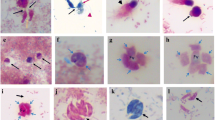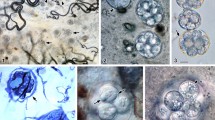Abstract
Colpodella species are free-living close relatives of apicomplexans that were recently reported to cause red blood cell infection in an immunocompromised human host and in a tick-borne human infection resulting in neurological symptoms. Unambiguous identification of the life cycle stages of Colpodella sp. using routine stains for light microscopy will aid rapid diagnosis in infections. Similarly, cells in culture and environmental samples can be rapidly identified by staining. Staining protocols are currently unavailable for cell detection by light microscopy. In this study, we investigated the feasibility of performing routine staining techniques for light microscopy for differentiating Colpodella sp. (ATCC 50594) and Bodo caudatus cysts in Hay medium cultures. We tested different basic and acidic dyes alone and in combination and also utilized a commercial trichrome staining protocol. The nonspecific fluorescent dye Calcofluor white was also evaluated. Staining times, dye concentrations, use of tap or distilled water rinses, use of a mordant and inclusion, or omission of decolorizers after staining were evaluated. We compared the intensity of color, clarity of morphological features, and cytoplasmic structures detected after staining. We report a new trichrome staining technique that allowed clear identification and differentiation of cyst stages of Colpodella sp. and B. caudatus. Immature Colpodella sp. cysts were identified as having an irregular, dual-colored (demilune), dark blue-purple and white appearance. Mature Colpodella sp. cysts stained dark red-blue and were identified in four-way mitotic division, while cysts of B. caudatus in diprotist or monoprotist (ATCC 30905) cultures were detected as spherical and red-pink in appearance.











Similar content being viewed by others
References
Bottari B, Ercolini D, Gatti M, Neviani E (2006) Application of FISH technology for microbiological analysis: current state and prospects. Appl Microbiol Biotechnol 73:485–494
Brugerolle G (2002) Colpodella vorax: ultrastructure, predation, life-cycle, mitosis, and phylogenetic relationships. Eur J Protistol 38:113–125
Cavalier-Smith T, Chao EE (2004) Protalveolate phylogeny and systematics and the origins of Sporozoa and dinoflagellates (phylum Myzozoa nom. Nov.). Eur J Protistol 40:185–212
El-Sayed NM, Hikal WM (2015) Several staining techniques to enhance the visibility of Acanthamoeba cysts. Parasitol Res 114:823–830
Janouškovec J, Tikhonenkov DV, Burki F, Howe AT, Kolísko M, Mylnikov AP, Keeling PJ (2015) Factors mediating plastid dependency and the origins of parasitism in apicomplexans and their close relatives. Proc Natl Acad Sci U S A 112:10200–10207. https://doi.org/10.1073/pnas.1423790112
Jiang JF, Jiang RR, Chang QC, Zheng YC, Jiang BG, Sun Y, Jia N, Wei R, Bo HB, Huo QB, Wang H, von Fricken ME, Cao WC (2018) Potential novel tick-borne Colpodella species parasite infection in patient with neurological symptoms. PLoS Negl Trop Dis 12(8):e0006546
Leboffe MJ, Pierce BE (2015) Microbiology laboratory theory & application, 4th edn. Morton Publishing Company, pp 205–207
Lukes J, Skalicky T, Tyc J, Votypka J, Yurchenko V (2014) Evolution of parasitism in kinetoplastid flagellates. Mol Biochem Parasitol 195:115–122
Matsimbe AM, Magaia V, Sanches GS, Neves L, Noormahomed E, Antunes S, Domingos A (2017) Molecular detection of pathogens in ticks infesting cattle in Nampula province, Mozambique. Exp Appl Acarol 73:91–102
Morin-Adeline V, Foster C, Slapeta J (2012) Identification of Chromera velia by fluorescence in situ hybridization. FEMS Microbiol Lett 328:144–149
Sam-Yellowe TY, Yadavalli R (2018) Giemsa staining and antibody characterization of Colpodella sp. (Apicomplexa). J Microbiol Moder Techn 3(1):103
Simpson AGB, Patterson DJ (1996) Ultrastructure and identification of the predatory flagellate Colpodella pugnax Cienkowski (Apicomplexa) with a description of Colpodella turpis n. sp. and a review of the genus. Syst Parasitol 33:187–198
Yadavalli R, Sam-Yellowe TY (2017) Developmental stages identified in the trophozoite of the free-living Alveolate flagellate Colpodella sp. (Apicomplexa). J Int Microbiol 20:178–183
Yuan CL, Keeling PJ, Krause PJ, Horak A, Bent S, Rollend L (2012) Hua XG (2012) Colpodella spp.–like parasite infection in woman, China. Emerg Infect Dis 18:125–127
Acknowledgments
We gratefully acknowledge Cleveland Clinic Lerner Research Institute, Cleveland Clinic NIH shared instrument grant for Orbitrap Elite LC-MS instrument; Cleveland Clinic NIH grant 1S100D023436-01 for Fusion Lumos instrument; and Cleveland Clinic Lerner Research Institute, Imaging Core. We thank Alberto Williams for assistance in staining and preparation of tables and Cleveland State University BGES stockroom staff Susan Moreno-Molek and Michelle Zinner for stain preparation.
Funding
The study was supported by funds from the Cleveland State University Undergraduate Summer Research Awards 2017 and 2019.
Author information
Authors and Affiliations
Corresponding author
Ethics declarations
Competing interests
The authors declare that they have no conflict of interest.
Additional information
Publisher’s note
Springer Nature remains neutral with regard to jurisdictional claims in published maps and institutional affiliations.
Rights and permissions
About this article
Cite this article
Sam-Yellowe, T.Y., Addepalli, K., Yadavalli, R. et al. New trichrome stains identify cysts of Colpodella sp. (Apicomplexa) and Bodo caudatus. Int Microbiol 23, 303–311 (2020). https://doi.org/10.1007/s10123-019-00104-1
Received:
Revised:
Accepted:
Published:
Issue Date:
DOI: https://doi.org/10.1007/s10123-019-00104-1




